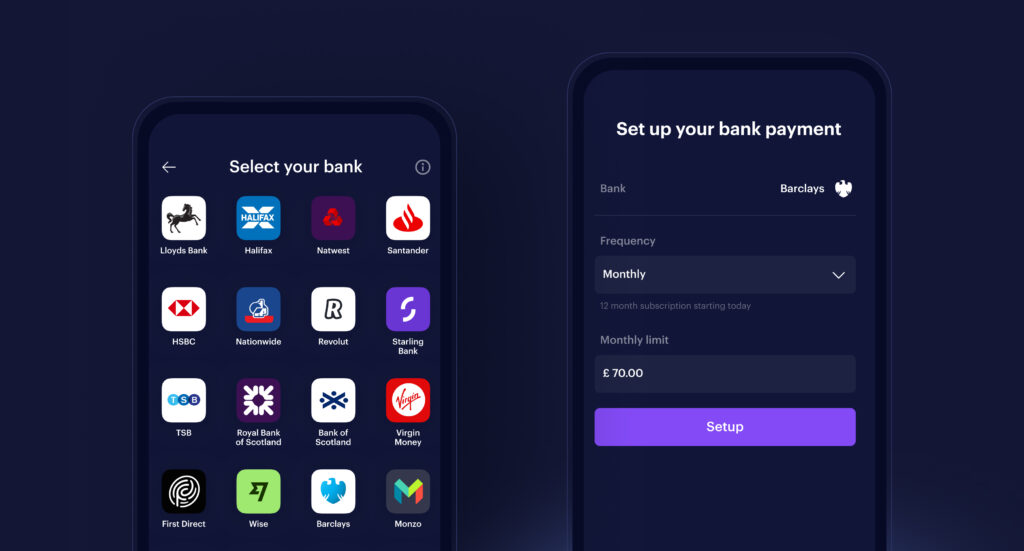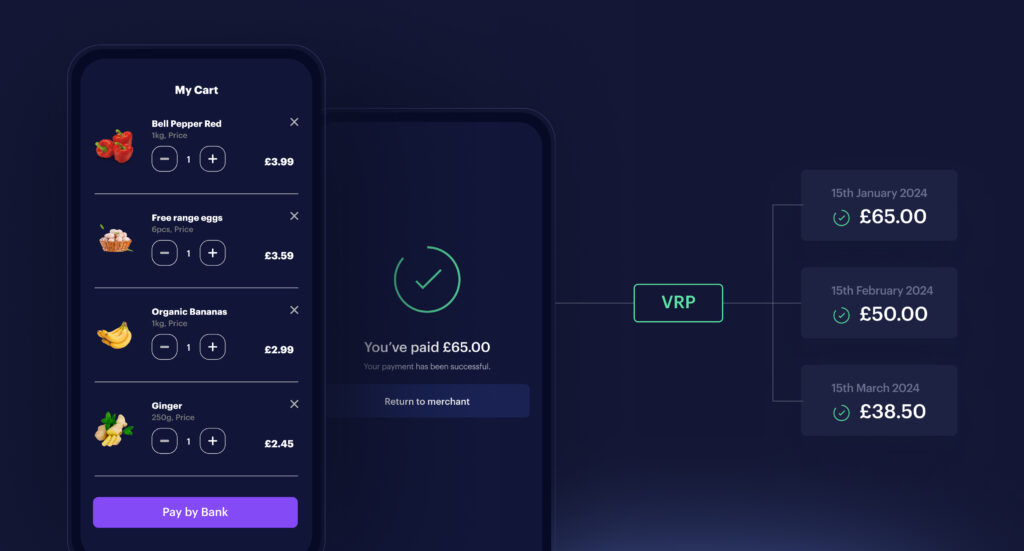
A guide to recurring account-to-account payment schemes
It was 60 years ago that the first-ever automatic funds transfer was set up in the UK, when Unilever executive Alastair Hanton wanted to establish a more efficient way of collecting funds from sellers of Wall’s ice cream. You could say this sweet treat played a pivotal role in shaping the way we pay; today, direct debits and recurring card payments are universal, covering everything from utility bills to streaming services.
But over the years, these models have run into problems. Businesses can lose revenue and face fees for failed payments, and despite being pulled directly from a consumer’s bank account direct debits can take several days to clear due to processing schedules. Meanwhile recurring card payments have higher costs and lower success rates compared to direct debit, since there’s the risk of the card itself being lost, stolen or expiring without new details being shared.
As open banking has been rolled out around the world, so too have new recurring payment schemes. Variable recurring payments (VRPs) in the UK, for example, are fast positioning themselves as a successor to direct debits. But what do equivalent systems look like elsewhere? Could ‘bank account on file’ replace ‘card on file’ – globally?
Let’s dive into how these look in action across different regions, and which markets we can expect to see them next.
Variable Recurring Payments (VRPs) in the UK
VRPs – regular payments in which customers can set parameters such as maximum amounts, frequency of payments and duration (e.g. over 12 months) – were established under standards of the Open Banking Implementation Entity (OBIE). Sweeping use cases, moving money from one account to another in the same name, were announced in 2021 and became available to both consumers and businesses in 2022.

The home country of the first automated funds transfer is soon moving into the next stage though; non-sweeping (also known as commercial) VRPs. NatWest was ahead of the game, trialling its commercial VRP offering PayIt in 2022 for trade-only plumbing and heating merchant Williams. But at the end of 2023, a timeline for trials was announced; the Joint Regulatory Oversight Committee (JROC) shared its plans to pilot consumer-to-business VRPs under a commercial API model later in 2024. Its success, however, relies on bank and market participation, and it’s hoped use cases will expand beyond the initial scope of utilities, government and financial service firms.
Online grocery shopping is a prime opportunity for freedom and flexibility. For example, a customer can set payments for their weekly food shop delivery, with a maximum spend of £70. One week they may only spend £50, while the next they reach the top end of their maximum amount – but both go through without a hitch since the VRP and its parameters were already set up and authorised.
VRPs will also benefit banks in the long run as, following the no-fee pilot, they may be able to charge for them, creating a new revenue stream through open banking. Mandated CMA9 banks’ commitment to building APIs to support VRPs is vital; only through true collaboration between banks, merchants, and TPPs can these payments become widely adopted and successful.

Europe’s dynamic recurring payments
In 2023 the European Payments Council (EPC) published its latest rulebook for the Single Euro Payments Area (SEPA) Payment Account Access (SPAA) scheme, with dynamic recurring payments (DRPs) on the agenda. Alongside the upcoming PSD3, SPAA – a voluntary initiative in which members apply to join – will enhance open banking to drive adoption and capabilities, having initially relied on the revised Payments Services Directive (PSD2) to facilitate real-time payments.
DRPs are similar to VRPs, in the sense that they offer increased flexibility over direct debits and recurring card payments. The functionalities of both are fundamentally the same, making them the perfect choice for amounts that differ upon each payment. DRPs will be classed as a ‘premium’ transaction enhancement that scheme members will be charged for to add to their capabilities.
While we wait for the arrival of DRPs, the European Parliament agreed to adopt the Instant Payments Regulation as an update to the SEPA rule. Timelines are now in place for banks and payment service providers in the EU to offer payments that settle within 10 seconds. This speed paired with the power of DRPs will bring fast, flexible payments unrivalled by direct debits and recurring card payments.
Brazil’s recurring Pix Automático
Brazil’s instant payment system, Pix, was launched by the Brazilian Central Bank in 2021. Its adoption in the market continues to increase at a remarkable pace; in 2023 transactions surpassed 42 billion, with 149 million active users.
Later in 2024 Pix will launch its Automático functionality, enabling recurring billing that consumers will have full autonomy over by setting transaction value limits, viewing upcoming payments, and more. The Brazilian Central Bank released guidelines for this feature at the end of 2023, stating that Pix participants that do not make Automático available to users for the launch date on 28th October 2024 will be fined for each day of delay, up to 60 days.
It’s the perfect option for businesses that already have a similar model set up, such as gyms, mobile phone operators and utility companies, or those looking to expand into a subscription service. Instead of juggling multiple contracts and paying fees for each, these companies can set up a single, standardised contract with Pix to cover all providers.
Australia’s PayTo real-time direct debits
PayTo is Australia’s real-time payments system, developed by the New Payments Platform Australia and launched in 2022. It offers a real-time alternative to direct debits which, unlike markets such as the UK where businesses can’t take direct debits on weekends or bank holidays, operates 24/7, 365 days a year.
Furthermore, users can either confirm a set amount or agree to a maximum amount to cater to fluctuations, similar to VRPs and DRPs. Accounts are validated in real-time when setting up a PayTo agreement is set up, so processing can begin immediately. Businesses are informed of customers’ actions, such as pausing or cancelling a subscription or membership, and both parties are notified when a payment has been successful.
India’s UPI AutoPay
India’s Unified Payments Interface (UPI), developed by the National Payments Corporation of India back in 2016, is another prominent instant payment system for peer-to-peer and B2C payments. Users set up a UPI ID, typically made up of their first name, part of their email address or phone number, and the initials of their bank. This virtual address identifies them in the UPI system and is what they need to transact through UPI.
Its functionality UPI AutoPay enables recurring payments for services such as bills, entertainment subscriptions and insurance, all authorised through their UPI-enabled app. Consumers can modify, pause or revoke their payments, and set maximum amounts depending on the merchant category.
Recurring payments elsewhere in APAC
While South East Asia has a successful real-time landscape, with these payments expected to reach $2.4 trillion by 2025, recurring A2A payments are still in their infancy. Bank Negara Malaysia (BNM) is setting a strong example with its AutoDebit feature, which – with one-off consent from the consumer – enables businesses to collect funds either ad-hoc or recurring payments.
Fawri+ in Bahrain
In MENA, some markets are progressing faster than others.
The Central Bank of Bahrain first launched its Electronic Fund Transfer System (EFTS) in 2015, followed by an Open Banking Framework (OBF) in 2020. Its service Fawri+, created under the Benefit – country’s Electronic Network For Financial Transactions – enables ‘near real time’ transfers. It also facilitates direct debit payments for automated billing once authorised by consumers which, like PayTo, run 24/7, every day of the year. Meanwhile Fawateer is mainly a service for consumers to consolidate bills from different issuers, but it also provides a direct debit service for funds for billers to automatically collect funds from a customer’s account with permission.
Keep recurring payments on your roadmap
The pace in which open banking capabilities are growing around the world is hard to keep track of. Being a global player, harmonising a world of APIs into a single point of access, Volt is keeping a close eye on timelines of new products to ensure we are staying to speed and preparing for next steps.
This includes exploring sweeping VRPs in the UK, moving money between accounts belonging to the same person (me-to-me), ahead of commercial VRPs, and working on adding Pix Automático to our own integration. Next up on our roadmap we’ll be launching recurring payments in Australia with PayTo, enabling our merchants to offer customers a seamless ‘one-click’ experience.
The success and revenue unlocked with recurring A2A payments will only grow as time goes on, so as a business operating similar models – direct debits or recurring card payments – we strongly recommend adding them to your strategy.
